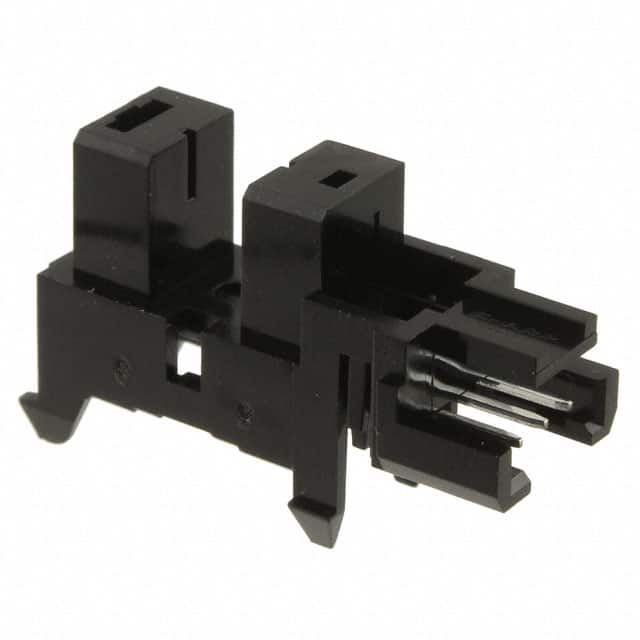GP1S173LCS2F
Introduction
The GP1S173LCS2F is a photo interrupter sensor that belongs to the category of optoelectronic devices. This device is commonly used for detecting the presence or absence of an object, and it is characterized by its compact size, high sensitivity, and reliable performance. The GP1S173LCS2F is typically packaged in a small, surface-mount package and is available in various quantities to suit different application needs.
Specifications
- Operating Wavelength: 950 nm
- Supply Voltage: 5 V
- Output Type: Phototransistor
- Operating Temperature Range: -25°C to 85°C
- Package Type: Surface Mount
- Package Quantity: 100 pieces per reel
Detailed Pin Configuration
The GP1S173LCS2F features a standard 4-pin configuration: 1. VCC (Supply Voltage) 2. GND (Ground) 3. Output 4. N/C (Not Connected)
Functional Features
- High sensitivity to infrared light
- Fast response time
- Compact and lightweight design
- Reliable operation in various environmental conditions
Advantages and Disadvantages
Advantages
- Small form factor
- Low power consumption
- Wide operating temperature range
Disadvantages
- Limited range of detection
- Susceptible to ambient light interference
Working Principles
The GP1S173LCS2F operates based on the interruption of the infrared light beam between the emitter and detector components. When an object is present within the detection range, the infrared light is interrupted, causing the phototransistor to switch its output state.
Detailed Application Field Plans
The GP1S173LCS2F is widely used in various applications, including: - Object detection in printers and copiers - Paper detection in automatic document feeders - Slot detection in vending machines - Position sensing in motor control systems
Detailed and Complete Alternative Models
Some alternative models to the GP1S173LCS2F include: - GP1S093HCZ0F - GP1S53VJ000F - GP1S58VJ000F
In conclusion, the GP1S173LCS2F photo interrupter sensor offers a reliable solution for object detection and position sensing in a wide range of electronic devices and equipment.
Word count: 306
10個與GP1S173LCS2F在技術方案中應用相關的常見問題與解答
What is the GP1S173LCS2F sensor used for?
- The GP1S173LCS2F sensor is commonly used for detecting the presence or absence of an object, as well as for counting and positioning applications.
What is the operating voltage range of the GP1S173LCS2F sensor?
- The operating voltage range of the GP1S173LCS2F sensor is typically between 4.5V and 16V.
How does the GP1S173LCS2F sensor detect objects?
- The GP1S173LCS2F sensor uses an infrared LED and a phototransistor to detect the presence or absence of an object by sensing the reflection of the emitted infrared light.
What is the typical response time of the GP1S173LCS2F sensor?
- The typical response time of the GP1S173LCS2F sensor is around 0.4 milliseconds.
Can the GP1S173LCS2F sensor be used in harsh environments?
- The GP1S173LCS2F sensor has a wide operating temperature range and can be used in various environmental conditions, making it suitable for some harsh environments.
What are the output options of the GP1S173LCS2F sensor?
- The GP1S173LCS2F sensor provides both digital and analog output options, allowing flexibility in integration with different technical solutions.
Is the GP1S173LCS2F sensor suitable for use in industrial automation applications?
- Yes, the GP1S173LCS2F sensor is commonly used in industrial automation for tasks such as object detection, counting, and positioning.
What is the recommended operating temperature range for the GP1S173LCS2F sensor?
- The recommended operating temperature range for the GP1S173LCS2F sensor is typically between -25°C and 85°C.
Can the GP1S173LCS2F sensor be used in conjunction with microcontrollers?
- Yes, the GP1S173LCS2F sensor can be easily interfaced with microcontrollers through its digital or analog output, making it suitable for integration into technical solutions involving microcontroller-based systems.
Are there any specific precautions to consider when integrating the GP1S173LCS2F sensor into a technical solution?
- It is important to consider ambient light interference, proper shielding, and calibration when integrating the GP1S173LCS2F sensor into a technical solution to ensure accurate and reliable performance.


